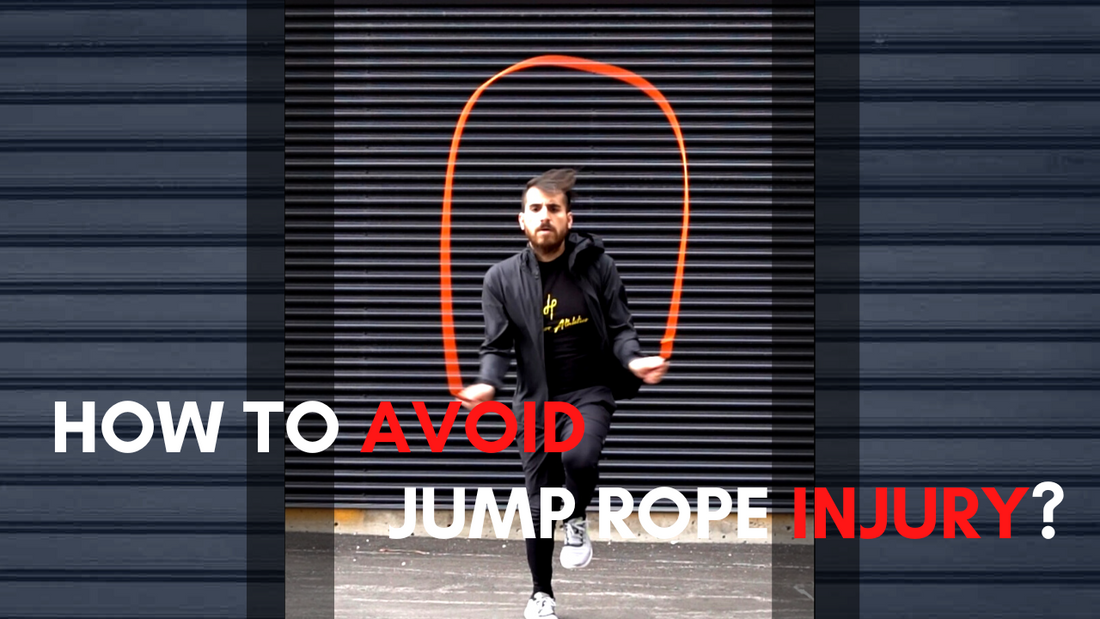
Overview
How to Avoid Injuries and Shin Splints While Jumping Rope? Jumping rope is a very dynamic exercise that engages several muscle groups. This is why experts consider it to be a calorie furnace.
However, it also exposes you to injuries. Standing up, lifting your body in the air, and coming into contact with the floor repeatedly can predispose you to Injuries, especially if you don’t take the necessary precautions.
One common injury that people experience is shin splints with jump rope. Getting injured this way means you are out of commission for at least a few days.
In this comprehensive guide, we will cover everything there is to know about how to avoid jump rope Injuries Injuries , including shin splints.
What causes shin splints during jumping rope?
Shin splints describe pain in the front of your lower leg – i.e., at the shin bone. Formally, sports medicine doctors refer to this condition as medial tibial stress syndrome (MTSS).
The incidence of shin splints is particularly common in people who perform strenuous physical activity (e.g., jumping rope)
In some cases, the pain is severe enough to immobilize you. Researchers believe that this condition has a cumulative nature. Differently put, repeated stress on the muscles, joints, and bones of the lower legs will ultimately cause shin splints.

The causes of shin splints
The leg pain triggered by shin splints is the result of months/years of repetitive micro-injuries that damage:
- Muscles
- Shinbone
- Connective tissues that connect everything together
The final result is inflammation and edema (i.e., swelling) of the muscles, which increases the pressure against the shinbone.
In certain cases, bone fractures could trigger stress reactions that lead to shin splints. Stress fractures do not have to be very pronounced. They often start with tiny cracks that eventually precipitate a large-scale inflammatory process.
Fortunately, giving your body enough rest will heal these cracks, which dampens the inflammation.
The risk factors of shin splints
As we already established, there are jumping rope exercises increase the risk of shin splints. However, there are other factors, which include:
- Flat feet and other anatomical abnormalities
- Weak muscles of the lower body (e.g., thighs, buttocks)
- Poor articular range of motion
- Improper jumping techniques
- Running long distances on hard surfaces (e.g., concrete)
- Running downhill
- Improper running technique
- Wearing inappropriate shoes
Scientists found that shin splints are more common in individuals with fatigued leg muscles and tendons.

Signs and symptoms of shin splints
When you develop shin splints, you can expect the following signs and symptoms:
- Achy pain located in the front of your lower leg
- Exacerbated pain during exercise
- Myalgia (i.e., muscle pain)
- Soreness along the inner part of the lower leg
- Edema of the lower leg
- Weak, numb feet
While these symptoms can be serious, they usually respond to common treatments. However, a small set of patients develop the following symptoms:
- Severe pain along the shin bone, especially after a traumatic event
- Feeling that your shin is unusually hot
- Extensive edema becomes is visible
- Shin pain even when you are resting
These signs and symptoms may be an indication of a severe complication.
How to figure out when something is wrong
The diagnosis of shin splints is typically made after taking your medical history and performing a physical exam.
Your doctor will ask you about the type of activities you engage in, their intensity, and frequency.
In case of doubt, your physician may order imaging tests, such as X-rays. The utility of these tests is to exclude fractures and other serious conditions (e.g., compartment syndrome).
Preventive measures to prevent jump rope Injuries
This section will be divided into two categories. The first will cover general tips to avoid jump rope injury, whereas the second section will specifically cover jump rope-related tips.
How to prevent jump rope Injuries – General tips
1. Keep up with strength exercises
In the past, strength training was thought to be harmful to fitness since a bigger muscle mass would negatively impact their flexibility and agility.
Today, strength training exercises are part of every athlete’s routine.
To use this method of training in your favor, focus on lifting heavier loads with a low number of repetitions.

2. Flexibility – sports massage
Sports massage is an excellent way to address chronic pain and several other conditions that affect the musculoskeletal system. It is also very effective in reducing your risk of injuries.
To put it in simple words, a sports massage is an act of pressing and manipulating the skin, muscles, tendons, and ligaments to relieve stress and induce relaxation; it could range from superficial massage to deep pressure techniques.
Today, massage therapy is recommended for all athletes to treat various injuries and prevent new ones.
3. Nutrition
Eating a balanced diet will provide your muscles and joints with the necessary nutrients to function properly.
When you are deficient in certain nutrients, your risk of injuries becomes significantly higher. For instance, vitamin D deficiency can predispose people to easy fractures, which is the worst thing that could happen to jump roper.
4. Don’t ignore niggles
During an intense jumping rope session, it is easy to get too hot-headed that you would ignore niggles. After all, they are part of training, right?
Wrong!
In reality, niggles are your body’s way of telling you that something is not right. Listening to your body could prevent up to 50% of injuries. Many athletes choose to continue competing even though they are experiencing unusual pain or discomfort. Of course, we are not saying that you should stop playing whenever you feel pain.
However, you do need to be aware of the nature of the pain you are feeling. Intense, acute pain that makes it difficult to walk or move is a red flag that you should stop playing.
5. Warm-up and cool-downs
For warmups, focus on low-impact exercises to increase your heart rate, breathing frequency, and blood flow. This will also allow the synovial fluid to circulate inside your joint capsules, preventing injuries during the game.
In recent guidelines about sports injuries, the best way to warm up for Injuries prevention is:
- Forward running (1-2 laps)
- Forward run with zig-zag (1-2 laps)
- One leg jump over a line
- Jumps in place
Cooling down is as important as warming up. The purpose of this phase is to lower your heart rate, cardiac output, and muscle engagement.
The duration of your cool-down should be around 5–10 minutes.
6. Sleep
Sleeping less than 7 hours can cause negative effects on your physical performance.
According to one study, lack of sleep decreases the time to physical exhaustion by up to 30%. In other words, if you typically run for 30 minutes before feeling tired, sleep deprivation can move this threshold to 20 minutes.
Additionally, sleep deprivation negatively impacts your physical strength and gas exchange. Your sweat glands will also become less effective at cooling your body.
Another study demonstrated a linear relationship between the amount of sleep athletes get and their risk of physical injuries.
If athletes sleep 6 hours or less, their risk of Injuries jumps to a whopping 80% during a single season. Sleeping 9 hours per day brings this number down to 15%–20%.
7. Ice baths
Ice baths can be very helpful after intense jump rope exercises.
The cold aids with muscle relaxation and prevents local inflammation from turning into a real issue. However, speak with your therapist about the optimal duration of ice baths since too much exposure can hurt your performance.
How to avoid jump rope Injuries – Specific tips
8. Opt for a softer surface
Jumping rope exercises should not be performed on very hard surfaces (e.g., concrete). This increases the explosive impact your joints and ligaments endure each time your jump. Instead, opt for a rubber mat or wooden floor as they would help with reducing the pressure on your musculoskeletal system.
9. Jump low to the ground
Many jumping rope newbies think that jumping higher would make the exercise more fruitful. However, the higher your jump, the bigger the risk of tearing your ligaments or developing shin splints.
A good place to start is jumping just high enough for the rope to pass under.
10. Choose your rope carefully
When purchasing a jumping rope, make sure it’s long enough to reach your shoulders when folded. If you get a short jump rope, your movements will be stiff, and you will have a hard time executing the jumps. Make sure the handles are neither too light nor heavy.
If you want to learn more about the characteristics of the appropriate jumping rope, check out this guideline (insert link).
11. Choose your skipping shoes wisely
The type of shoes you wear is as important as the surface you’re jumping on (if not more important). Therefore, get you a pair of well-fitted running shoes that absorb landing shock. They should also cushion your feet and support your ankles.
No matter what, do not jump rope while barefoot!
12. Rest between skipping sessions
One important tip to avoid shin splints with jump rope is not to exercise every day. This is especially vital for beginners. When you first start, your musculoskeletal system needs time to adapt to the new pattern of movements. Therefore, resting is crucial to allow your muscles to recover.
The same applies to your ligaments, tendons, and joints.
Takeaway message
Following our tips to prevent jump rope Injuries is indispensable to keep up your progress and avoid shin splints. Make sure to speak with your primary care physician if you have any concurrent medical conditions.
We hope that this article will serve as a miniguide to prevent jump rope Injuries. However, the information provided above does not replace the opinion of a healthcare professional.
If you have any questions about how to avoid jump rope Injuries or shin splints, feel free to share them in the comment section below.
Prev post

Jump Rope Vs. Running – Which One Is Better?
Updated on 09 December 2024
Next post

New Year Resolution With Jump Rope !
Updated on 09 December 2024




